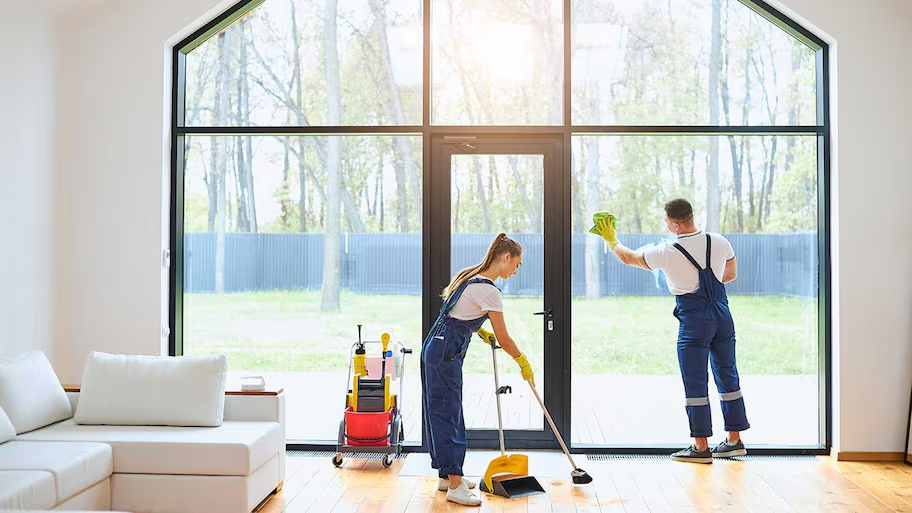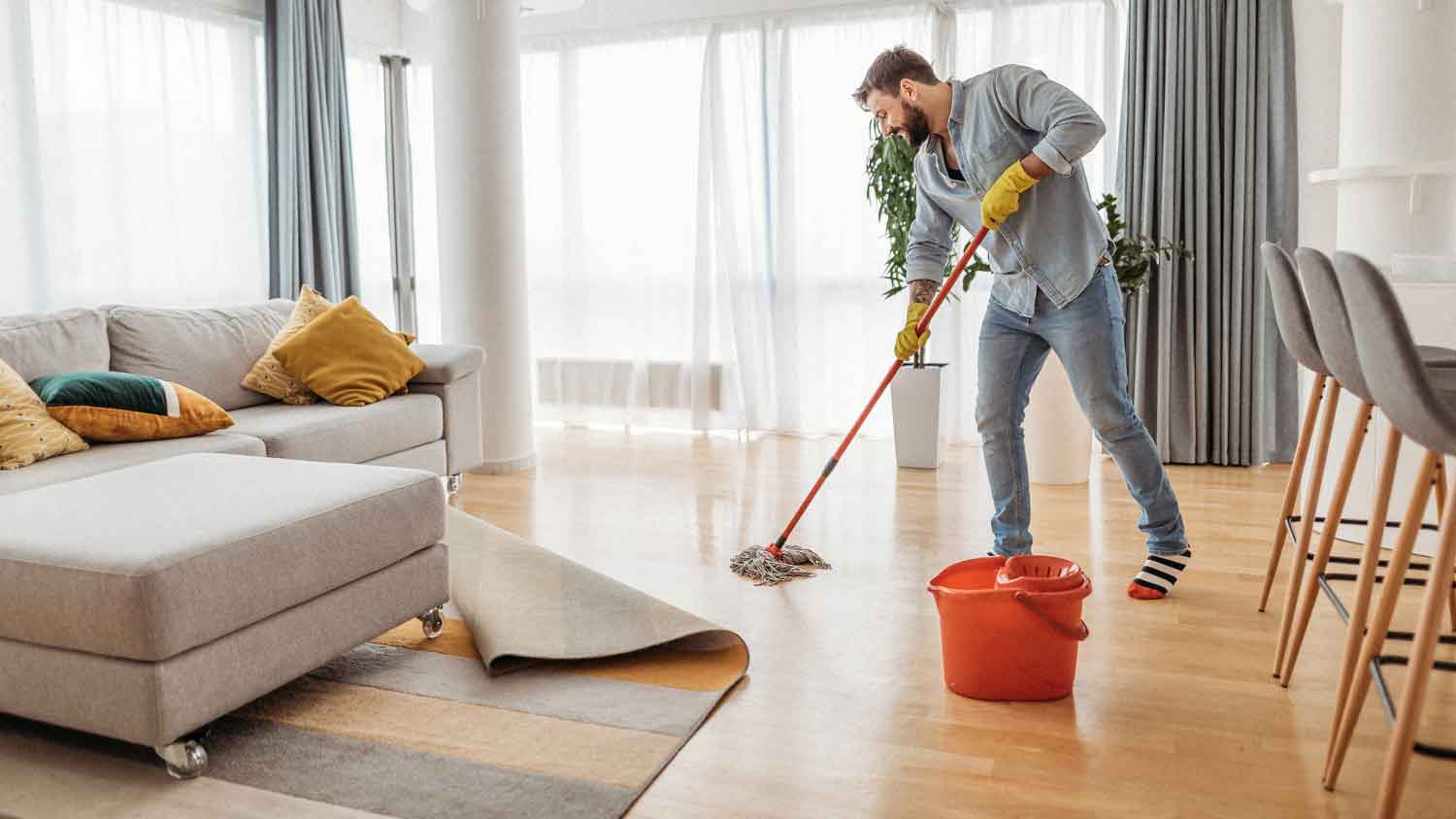How to Get Hard Water Stains off Your Stainless Steel Sink—Once and for All
Your cell reception may be spotty, but your sink doesn’t have to be


There’s nothing like the fresh feeling of a clean and dish-free kitchen sink… and nothing like a speckling of hard-water spots to ruin it. Along with being an eyesore, hard water stains can increase the likelihood of your kitchen sink rusting and leaking, which could lead to expensive repairs and replacements. Fortunately, there are plenty of easy and affordable ways to deal with hard water stains on the fly. Keep reading to find out how to clean stainless steel sink hard water stains with items you likely already have in your pantry.
Why Does Hard Water Leave Spots on Stainless Steel?
Before we talk about how to remove hard water stains from stainless steel, let’s make sure we understand the problem. Why are those spots getting left behind in the first place?
“Hard” water refers to water with a higher concentration of dissolved minerals, primarily calcium and magnesium. While it’s not a health hazard, hard water can be a bit of a nuisance in your home—in part because it leaves behind those stubborn spots.
“A water softener can help increase the life span of your plumbing, your water heater, and even your clothing.”
— Johnny Pujol, CEO and Water Expert for Tap Score Water Testing and SimpleLab, Inc., Berkeley, CA
Hard water can also make your soap less sudsy and even negatively impact the longevity of your appliances—including your sink. That’s why many homeowners who notice multiple signs of hard water end up installing a water softener.
How to Clean Stainless Steel Sink Hard Water Stains

Now that we know why hard water leaves a spotty trail, let’s talk about how to get hard water stains off of stainless steel so that you can enjoy that nice, shiny finish.
1. Take Action With Acids
Did you know cleaning is basically chemistry? Both calcium and magnesium, the two primary minerals that make hard water hard, are basic, which means acidic substances can neutralize and remove them. You probably already have some acids handy in your kitchen. Two great choices are white vinegar and lemon juice. If you’ve got either of those, an empty spray bottle, and a soft rag, you’re in business.
However, because stainless steel sinks are prone to long-term staining and damage, we highly recommend spot-testing the vinegar somewhere inconspicuous before applying it to your entire sink. Although most household vinegars are mild enough for this purpose, it’s better to be safe than sorry.
To get hard water stains off your stainless steel sink, try spraying white vinegar or lemon juice over the surface of your sink. Let it sit for 10 minutes before wiping it away with a soft cloth.
Note: If you’re using vinegar, be sure to opt specifically for distilled white vinegar, which has a higher concentration of acetic acid than apple cider, balsamic, rice wine, or red wine vinegars do. (Plus, it’ll leave behind a nice, neutral odor—unlike its more salad-dressing-friendly counterparts.)
2. Break Out the Baking Soda
If you remember high school chemistry class, you know that baking soda is actually a base, not an acid—but it can still be a boon in the fight against stubborn hard water spots. While rough, abrasive materials can damage your stainless steel sink, baking soda offers just enough exfoliating properties to gently lift away spots without leaving your sink scuffed and scratched.
Sprinkle the baking soda around your sink and use a non-scratch sponge or other soft cloth to gently erase those hard water spots. For extra cleaning power, you can combine the baking soda method with the acid method above by spraying vinegar or lemon juice after applying the baking soda. This may allow the stains to come up even more easily.
Psst: Out of baking soda? Cream of tartar can work for this, too.
3. Try Olive Oil
Yes, this list may sound a bit more like a recipe than a cleaning how-to, but hear us out because your favorite fat can spot-remove just as well as it can sauté.
To use olive oil to remove hard water stains from your sink, apply a small amount of the fat to a paper towel and rub it into the stainless steel, being sure to go with the grain. (It’s important to make sure your sink is clean and dry first.) After you’ve oiled up your sink to a nice shine, you can wipe away the excess with a clean, soft rag.
4. Get Out Your Glass Cleaner
If you have a commercial glass cleaner in your cabinet, you can use it after the above steps to bring your sink back up to a high-gloss shine.
Again, just be careful to spot-check in an inconspicuous location. Abrasive home cleaners, like chlorine bleach and chloride, can strip the protective barrier on your stainless steel sink, damaging the steel and causing it to dip. Additionally, you should never use abrasive cleaning tools like steel wool pads, brushes, or scrubbers, which can irreversibly scratch your sink.
5. Dry Your Sink After Each Use
This one isn’t a method for removal so much as a way to keep hard water stains from showing up in the first place. Nonetheless, it’s effective.
The reason hard water stains appear on stainless steel is because hard water pools and dries on the surface. By drying your sink each time you use it, you’ll avoid having to deal with them. A soft cleaning rag or microfiber cloth is a great choice for this practice. It may seem like a pain at first, but eventually it’ll be muscle memory.
More Tips for Dealing With Hard Water Stains—and Other Related Problems

As frustrating as hard water stains on stainless steel are, as you can see, they’re not impossible to eliminate. In fact, dealing with them can be something of a tasty trip through your pantry. The methods used above can also be applied to other appliances that are plagued by hard water stains. Using a gentle acid can help remove scale buildup in coffee makers, dishwashers, and more.
However, if you really want to tackle hard water stains at the source, installing a water softener can go a long way. While a water softening system costs $1,500 on average, over time, it can actually save you money by increasing the longevity of your appliances. Contact your local water softener installer to get started today.
Frequently Asked Questions
Removing hard water stains by using baking soda, lemon juice, vinegar, or some combination of all three will give you a nice, even surface to work with. Then, you can use olive oil to give your steel a nice shine, wiping away the remainder with a soft cloth. Glass cleaners and other commercial products may also help, but always be sure to spot-test before using new products on your sink—stainless steel can be finicky.
Most household vinegars are mild enough not to damage stainless steel—and can go a long way toward removing limescale and other dirt and grime. However, when combined with salt, vinegar can have a corrosive effect on metal, speeding the rusting process and also potentially damaging any rubber fittings near your sink or in your dishwasher.
While stainless steel is quite durable, it is susceptible to scratching. If you use rough, abrasive cleaning tools like steel wool or brushes, you may wind up with scuffs in your stainless steel sink. Additionally, harsh household chemicals including chloride bleach can damage your sink’s finish and decrease its life span.





- How to Remove Hard Water Stains From 5 Different Household Surfaces
- How to Remove Tough Hard Water Stains
- 3 Effective Ways to Remove Hard Water Stains From Glass
- Black Stainless Steel Sink Pros and Cons: What to Know Before You Buy
- 7 Easy Fixes for Removing Hard Water Stains from Exterior Windows
- How to Remove Hard Water Stains from Your Dishes
- How To Remove Rust From Stainless Steel: Transform Your Appliances and Cookware
- How to Clean Your Kitchen Sink No Matter the Material
- How to Treat Hard Water and Its Effects: 5 Methods to Try
- How to Remove Scratches From Stainless Steel Appliances in Under 25 Minutes









